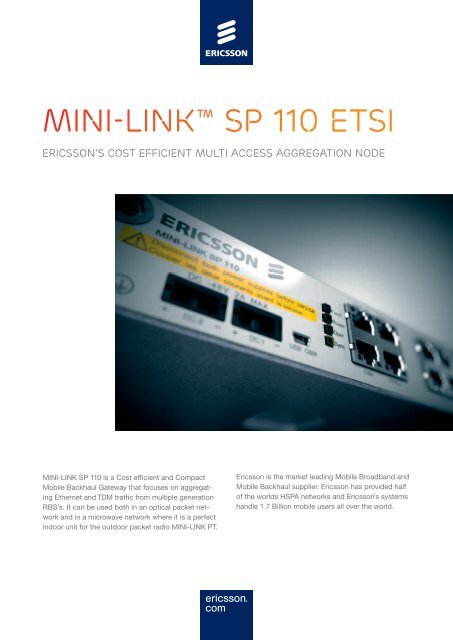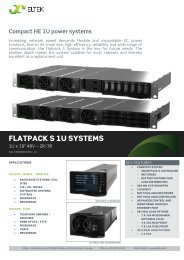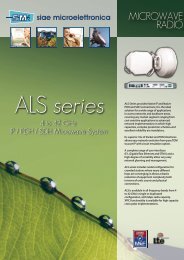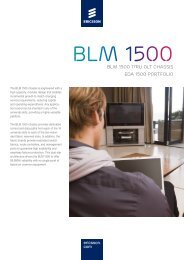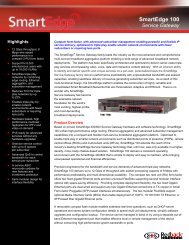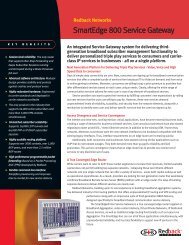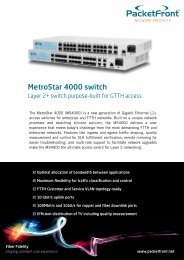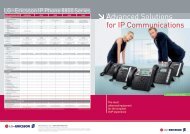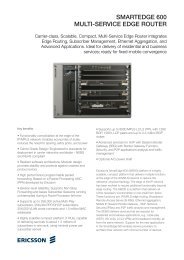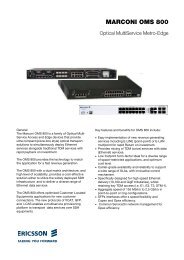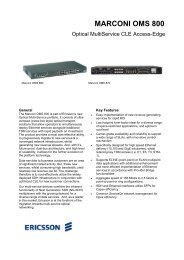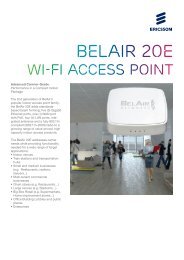LZT 110 5200 R2 ETSI Mini-LinkSP 110.indd
LZT 110 5200 R2 ETSI Mini-LinkSP 110.indd
LZT 110 5200 R2 ETSI Mini-LinkSP 110.indd
Create successful ePaper yourself
Turn your PDF publications into a flip-book with our unique Google optimized e-Paper software.
MINI-LINK SP <strong>110</strong> <strong>ETSI</strong><br />
Ericsson’s cost efficient Multi Access Aggregation Node<br />
MINI-LINK SP <strong>110</strong> is a Cost efficient and Compact<br />
Mobile Backhaul Gateway that focuses on aggregating<br />
Ethernet and TDM traffic from multiple generation<br />
RBS’s. It can be used both in an optical packet network<br />
and in a microwave network where it is a perfect<br />
indoor unit for the outdoor packet radio MINI-LINK PT.<br />
Ericsson is the market leading Mobile Broadband and<br />
Mobile Backhaul supplier. Ericsson has provided half<br />
of the worlds HSPA networks and Ericsson’s systems<br />
handle 1.7 Billion mobile users all over the world.
MINI-LINK SP <strong>110</strong><br />
the cost efficient Mobile backhaul gateway<br />
rBS interface and demarcation point<br />
As a Mobile Backhaul Gateway MINI-LINK SP <strong>110</strong> is<br />
located at the edge of the Mobile transport network<br />
interfacing directly to the Radio Base Stations. It provides<br />
backhaul transmission for existing and future<br />
bandwidth demanding mobile broadband services.<br />
MINI-LINk SP <strong>110</strong> is a Cost efficient end node or<br />
small hub in optical networks.<br />
It is easy to install and configure. It aggregates Ethernet<br />
traffic from local sites with 8 Gbps full duplex,<br />
non-blocking, switching capacity. TDM traffic is handled<br />
by use of Circuit emulation, and Traffic protection<br />
can be done by use of e.g. LAG, ERP or RSTP/MSTP.<br />
E2e management is done with ServiceOn, a common<br />
management system for all Ericsson transmission<br />
products. Ethernet Service OAM is available for<br />
error-tracing and supervision. MINI-LINK SP supports<br />
multi-vendor environment<br />
4g/3g/2g 4G/3G/2G<br />
MINI-LINk MINI-LINK<br />
SP <strong>110</strong><br />
OMS<br />
1410<br />
Packet switched<br />
Network<br />
MINI-LINK MINI-LINk<br />
SP <strong>110</strong><br />
G.8032 g.8032<br />
gE GE ring<br />
MINI-LINk MINI-LINK<br />
SP <strong>110</strong><br />
MINI-LINK SP <strong>110</strong> provides E1 emulation at the backhaul<br />
interface for 2G networks and Fast Ethernet/<br />
Gigabit Ethernet for 3G/ 4G backhaul. It also provides<br />
multiple sync input/output options for maximum<br />
synchronization solution flexibility. The backhaul<br />
service is supported by MEF-defined Ethernet virtual<br />
connections: point-to-point E-Line and multipoint-tomultipoint<br />
E-LAN services.<br />
As a circuit emulation gateway, MINI-LINK SP <strong>110</strong><br />
incorporates the latest CESoPSN and SAToP standards.<br />
When acting as a demarcation device,<br />
MINI-LINK SP <strong>110</strong> supports the expected UNI functionality<br />
as well as Ethernet Service OAM. The device<br />
enables the separation of different network segments<br />
as well as different business responsibility areas.<br />
MINI-LINk MINI-LINK<br />
SP <strong>110</strong><br />
MINI-LINk SP is the compact indoor unit for the<br />
outdoor packet microwave terminal MINI-LINk Pt.<br />
The combination offers a number of carrier grade<br />
functions; up to 1 Gbps microwave capacity per link,<br />
Multiple Ethernet ports, aggregation of traffic from<br />
south-bound and local sites, local access to DCN<br />
without disturbing traffic, TDM support via Circuit<br />
Emulation Services and Ethernet Service OAM.<br />
Up to four MINI-LINK PT radios can be used per<br />
MINI-LINK SP <strong>110</strong>.<br />
MINI-LINk MINI-LINK<br />
Pt PT 2010<br />
4g/3g/2g<br />
4G/3G/2G<br />
Packet switched<br />
Network<br />
MINI-LINK MINI-LINk<br />
SP <strong>110</strong><br />
MINI-LINk MINI-LINK<br />
Pt PT 2010<br />
MINI-LINk MINI-LINK<br />
Pt PT 2010<br />
MINI-LINk MINI-LINK<br />
TN tN<br />
4g/3g/2g<br />
4G/3G/2G
Ethernet switching<br />
The integrated non blocking Gigabit Ethernet switch<br />
(IEEE 802.1Q and 802.1ad compliant) has a switching<br />
capacity of 8 Gbps Full duplex, 16 Gbps Half duplex.<br />
Ethernet Protection<br />
MINI-LINK SP <strong>110</strong> offers multiple protection options<br />
like LAG (802.1AX Link Aggregation),<br />
Ethernet Ring Protection (ITU G.8032v2) and<br />
RSTP/MSTP.<br />
Quality of Service<br />
Service differentiation (802.1 p-bits) and traffic separation<br />
(VLAN) together with 8 priority queues and<br />
traffic scheduling makes MINI-LINK SP <strong>110</strong> prepared<br />
for diverse QoS configurations. The QoS is Ethernet,<br />
IP and MPLS aware.<br />
MINI-LINK SP <strong>110</strong> provides Carrier Grade QoS functions<br />
like SPQ, WFQ, WRED and Policing.<br />
Both ingress and egress Policing are available for<br />
configuring Service Levels that enable network carriers<br />
to provide end-to-end guaranteed bandwidth and<br />
service level agreements.<br />
Connection-oriented logical flows can be established<br />
with MEF 10.1 defined Service Attributes: Committed<br />
Information Rate (CIR), Committed Burst Size (CBS),<br />
Excess Information Rate (EIR), and Excess Burst Rate<br />
(EBS). The attributes are configurable per flow.<br />
Virtual LAN (VLAN)<br />
MINI-LINK SP <strong>110</strong> supports VLAN tagging (IEEE<br />
802.1Q) and Provider Bridge (802.1ad).<br />
Ethernet OAM<br />
As part of end-to-end network solutions,<br />
MINI-LINK SP <strong>110</strong> complies to Link OAM (IEEE<br />
802.3ah) and Ethernet OAM (IEEE802.1ag); together<br />
with Ethernet PM (ITU-T Y.1731).<br />
Circuit Emulation Service<br />
MINI-LINK SP <strong>110</strong> provides circuit emulation services<br />
for legacy E1 TDM interfaces.<br />
The SAToP (Structure Agnostic TDM over Packet)<br />
emulation method disregards any structure that may<br />
be imposed on the data stream; e.g. the standard<br />
framing as defined in ITU-T G.704. The emulation<br />
endpoints do not interpret the TDM structure nor<br />
participate in the TDM signaling.<br />
The CESoPSN (Circuit Emulation Service over<br />
Packet Switched Network) emulation is a structure<br />
aware Pseudowire encapsulation method. The ITU-T<br />
G.704 TDM structure can be identified, and recreated<br />
at the remote end.<br />
MINI-LINK SP <strong>110</strong> is hence well equipped to cater for<br />
the needs of different network technologies and CES<br />
head-end requirements.<br />
Clock Synchronization<br />
MINI-LINK SP <strong>110</strong> has a comprehensive range of synchronization<br />
possibilities. This makes it prepared for a<br />
variety of synchronization scenarios.<br />
The Gateway allows different clock sources:<br />
• Synchronous Ethernet, (ITU-T G.8261/<br />
G.8262/G.8264)<br />
• Precision Time Protocol, PTP, (IEEE 1588v2 client)<br />
• Adaptive clock recovery based on the RTP packet<br />
stream from the Packet Switched Network (PSN).<br />
• E1 Line clock<br />
• Local clock<br />
MINI-LINK SP <strong>110</strong> furthermore provides a separate<br />
2 MHz clock input and output sync port, as well as a<br />
sync port dedicated for TDD base station sync requirements,<br />
such as Time Of Day (TOD) and 1pps input.<br />
Alarm Interface<br />
The alarm interface of the MINI-LINK SP <strong>110</strong> provides<br />
four user inputs together with two user outputs.<br />
Management<br />
Management is handled by ServiceOn EM.<br />
Local management can be performed by either using<br />
the Local Craft Tool (LCT) or a Command Line Interface<br />
(CLI).<br />
Cooling<br />
MINI-LINK SP <strong>110</strong> comes with a front-mounted fan unit.<br />
The fan unit can be replaced without traffic interruption.<br />
Power<br />
Power is supplied by -48 VDC through dual fuse<br />
protected power inlets.<br />
Subrack solutions<br />
MINI-LINK SP <strong>110</strong> is ready for wall-mounting or<br />
installation in 19”/<strong>ETSI</strong> racks.<br />
MINI-LINK SP <strong>110</strong> is<br />
ready for deployment<br />
in all wireless mobile<br />
network Generations,<br />
2G, 3G and 4G!
TECHNICAL SPECIFICATIONS<br />
Weight and dimension<br />
Physical Dimension: Height 1 U,<br />
Depth 220 mm, Width 446 mm. Weight: 4 kg<br />
Power Supply<br />
-48 V DC<br />
Power consumption<br />
Typical 35 W<br />
Traffic Interfaces<br />
4 x GE SFP ports<br />
4 x 10/100/1000BASE-T ports<br />
8 port E1 120/100/75 Ohm RJ-45 Circuit Emulation<br />
Maintenance Interfaces<br />
USB port for local configuration and management<br />
One out of band 10/100/1000BASE-T Ethernet<br />
management port<br />
Sync Interfaces<br />
2 MHz G.703 §13 in/out Synch port (RJ-45)<br />
1pps + Time Of Day (TOD) Synch port (RJ-45)<br />
Operating Environment<br />
Operating Temperature: -5°C - 55°C<br />
Humidity: 0 - 95% Non-condensing<br />
Air flow: Front to back supported by fan<br />
Ethernet Switching<br />
802.1Q Virtual LAN<br />
802.1ad Provider Bridging<br />
Switching capacity: 8 Gbps non-blocking Full duplex<br />
Line rate from 64 byte to 9600 byte MTU<br />
32 K MAC addresses<br />
QoS<br />
MEF QoS (MEF 10.1) utilizing<br />
• PCP, Ethernet<br />
• DSCP, IP<br />
• EXP, MPLS<br />
8 queues, Strict Priority and/or WFQ scheduling<br />
Policing from 64kbps to 1Gbps WRED<br />
Ethernet Services<br />
Private Line (EPL), Virtual Private Line (EVPL),<br />
Private LAN (EPLAN), Virtual Private LAN (EVPLAN)<br />
Layer 2 Protocols<br />
802.1Q Virtual LAN<br />
802.1ad Provider Bridging<br />
802.1AX Link Aggregation, LAG<br />
ITU G.8032v2 Ethernet Ring Protection<br />
RSTP/MSTP<br />
TDM Support<br />
E1 Circuit Emulation<br />
• SAToP (Structure Agnostic TDM over Packet); IETF<br />
RFC 4553 & MEF 8<br />
• CESoPSN (Circuit Emulation Service over Packet<br />
Switched Network); IETF RFC 5086 & MEF 8<br />
Timing and synchronization<br />
IEEE 1588v2 Client<br />
ITU-T G.8261/G.8262/G.8264 Synchronous Ethernet<br />
OAM<br />
IEEE 802.3ah Link OAM<br />
IEEE 802.1ag Service OAM Fault Management<br />
ITU-T Y.1731 Service OAM Performance Management<br />
MTBF<br />
Typically 75 years<br />
SECURITY<br />
RADIUS/TACACS+<br />
authentication of management users<br />
Storm Protection<br />
Access Control List (ACL)<br />
Network Management<br />
RADIUS<br />
SNMP<br />
XML<br />
Syslog<br />
RMON<br />
SSHv2,<br />
ServiceOn EM<br />
Standards and Recommendations<br />
<strong>ETSI</strong> EN 60950, EN 300 386<br />
RoHS-6<br />
MEF 9, MEF 14<br />
Ericsson AB<br />
SE-431 84 Mölndal, Sweden<br />
Telephone +46 10 719 00 00<br />
Fax +46 10 712 99 99<br />
www.ericsson.com<br />
EN/<strong>LZT</strong> <strong>110</strong> <strong>5200</strong> <strong>R2</strong> <strong>ETSI</strong><br />
© Ericsson AB 2011<br />
This datasheet describes features available in the 1.0, 1.1 and 1.2<br />
release of MINI-LINK SP <strong>110</strong>. Please contact your sales representative<br />
for further information about the availability of a specific feature.<br />
All technical data is typical and is subject to change without notice


